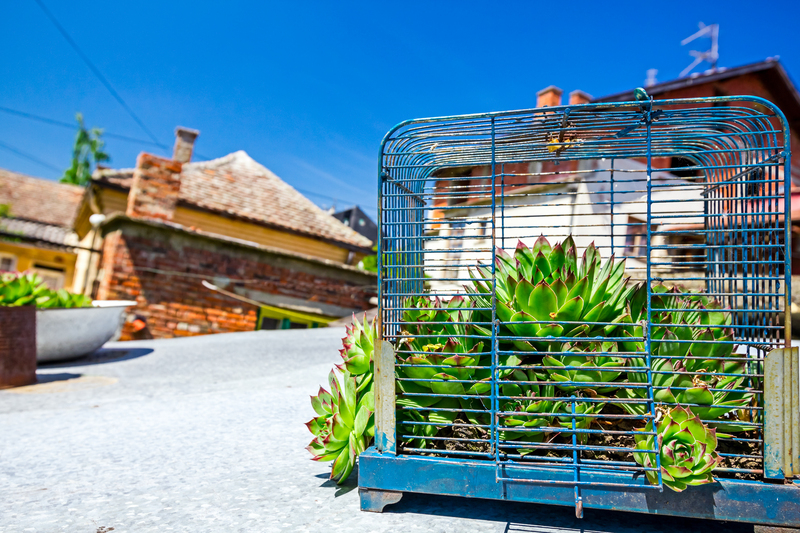Creating a Dog-Friendly Garden: Tips and Tricks
Posted on 20/09/2025
Creating a Dog-Friendly Garden: Tips and Tricks
Are you a dog lover looking to create a beautiful outdoor space that accommodates your furry friend? A dog-friendly garden not only keeps your canine companion happy and safe but also helps preserve the beauty and function of your landscape. In this comprehensive guide, you'll discover essential strategies, plant choices, and design ideas for cultivating a garden that both humans and dogs can enjoy. Let's dive into the world of dog-proof landscaping!
Why Design a Dog-Friendly Garden?
Our pets are cherished members of the family, and just like any loved one, it's vital to consider their needs in every aspect of our lives--especially in our gardens and outdoor areas. A pet-friendly garden ensures your dog can play, explore, and relax without putting themselves or your plants at risk.
- Safety: Protect your pup from toxic plants and garden hazards.
- Entertainment: Offer sensory stimulation and engaging experiences.
- Durability: Minimize damage to lawns and flower beds caused by digging and running.
- Well-being: Support your dog's mental and physical health with outdoor access.
By following dog garden tips and implementing smart design strategies, you can have both a happy pet and a thriving garden.

Planning Your Dog-Friendly Backyard
Thoughtful planning is key when it comes to developing a garden that suits both people and pets. Here's how to start:
Assess Your Dog's Behavior
- Does your dog love to dig?
- Are they a high-energy breed needing lots of space to run?
- Do they chew or nibble on plants?
- Are they prone to escape attempts or are they a relaxed, older dog?
Understanding your canine's habits helps you adapt your landscape accordingly, prioritizing areas for play, shade, relaxation, and essential boundaries.
Select a Safe and Secure Perimeter
It's crucial to have a secure fence around your pet-friendly garden. Consider these fencing tips:
- Height: Ensure the fence is tall enough for your breed's jumping ability.
- Material: Choose durable and chew-proof materials.
- Burrowing guards: If your dog is a digger, install barriers continuing below ground.
- Visibility: For anxious dogs, privacy fences might reduce barking triggered by passersby.
Regularly inspect fences for signs of wear, holes, or loose panels to maintain safety.
Designate Paths and Play Zones
Dogs naturally create "paths" in the garden, choosing the quickest route between their favorite spots. Incorporate these natural lines into your design:
- Create mulched or gravel paths that withstand frequent use and muddy paws.
- Designate a play area--use artificial turf or robust grass for fetch and tug-of-war games.
- Ensure pathways are wide enough for your dog to move comfortably.
Marking out dog-proof garden paths encourages your pet to stick to designated routes, reducing damage to delicate plants and flower beds.
Dog-Safe Plants and Materials
Choose Non-Toxic, Hardy Plants
Some common garden plants can be toxic to dogs. It's important to choose varieties that are safe--even if chewed or trampled. Some dog-friendly garden plants include:
- Sunflowers
- Snapdragons
- Roses (watch the thorns)
- Marigolds
- Calendula
- Spider Plants
- Ornamental grasses
_Avoid planting_ dangerous varieties such as azaleas, foxgloves, oleanders, sago palms, and lilies. Always consult a reliable source for a complete list, such as the ASPCA's toxic and non-toxic plant database.
Pick Pet-Safe Ground Covers
Traditional lawns can struggle with regular dog activity. Instead, experiment with dog-tolerant ground covers:
- Creeping thyme: Aromatic, resilient, and safe for dogs.
- Clover: Soft, green, and less susceptible to urine spots than grass.
- Buffalo grass: Tough and drought-resistant.
- Artificial turf: Low-maintenance and mud-free (ensure pet-safe materials!)
_Remember:_ All surfaces should be gentle on paws and not retain excessive heat in the summer months.
Mulch and Mulching Alternatives
While mulch is excellent for moisture retention and weed suppression, not all types are pet-safe. Steer clear of cocoa mulch (toxic if ingested) and choose:
- Pine, cedar, or hemlock bark chips (check for pet safety, as some dogs can be sensitive to aromatic oils)
- Wood chips (untreated and non-toxic)
- Pea gravel (rounded stones with no sharp edges)
Watch your dog for signs of chewing or eating mulch and swap materials if necessary.
Avoiding Garden Hazards for Dogs
Be Cautious with Chemicals
Many common garden chemicals are dangerous to dogs. To create a truly dog-safe garden:
- Avoid chemical fertilizers, pesticides, and herbicides.
- Choose organic or pet-safe plant care products.
- Store all garden chemicals in secure, out-of-reach places.
Consider natural pest control options like beneficial insects, soapy water sprays, or companion planting.
Compost with Care
- Keep compost bins securely lidded and inaccessible.
- Never compost bones, dairy, or fatty foods, which can attract dogs.
- Beware: decomposing organic matter can harbor bacteria harmful to pets.
Remove Dangerous Objects
- Keep sharp tools and pruners out of your pet's reach.
- Collect fallen branches, sticks, or debris that could be choking hazards.
- Store hoses and irrigation equipment safely after use.
Features to Enrich Your Dog-Friendly Garden
Provide Ample Shade and Shelter
Dogs can quickly overheat outdoors, especially during summer. Include shady spots where your pet can cool down:
- Mature trees or strategically planted shrubs
- Pergolas or dog-safe umbrellas
- Outdoor dog houses or shaded kennels
Your pet will thank you for a cool, quiet place to relax after playtime!
Create Watering Stations
- Set up a fresh water bowl or dog fountain in a convenient spot.
- Consider a splash pool for pups that love water, ensuring it's shallow and easy to clean.
Designated Digging Spots
If your dog is a natural digger, channel the urge with a specific "dig zone":
- Sandpits or loose soil areas for enrichment
- Encourage use by hiding toys or treats in the digging zone
- Discourage digging in other parts of the garden with decorative rock barriers or low fencing around beds
Dog-Friendly Play Equipment
- Tunnel toys, ramps, and agility features spark interest and physical activity.
- Sturdy, non-toxic chew toys keep pups entertained outdoors.
- Rotating toys and features helps prevent garden boredom.
Attractive and Practical Dog Garden Design Ideas
Multi-Level Landscaping
Integrate raised beds, steps, and gentle slopes for visual appeal and to separate dog areas from ornamental beds. Always ensure steps and elevations are easy for your dog to navigate and free from sharp drops.
Screening and Barriers
- Child-safe garden gates to restrict access to sensitive areas
- Decorative fencing around vegetable beds or delicate flowers
- Natural hedges such as boxwood or dog-safe shrubs to create visual boundaries
Low-Maintenance Garden Choices
- Select resilient shrubs and perennials that can bounce back from occasional canine traffic.
- Opt for planters and hanging baskets for fragile or toxic plants, keeping them out of reach.
Sensory Garden Elements
Add scented, edible, or tactile plantings for your dog's enrichment. Try:
- Lemongrass, lavender, and chamomile for gentle, calming scents
- Edible herbs like basil and parsley
- Soft foliage plants such as lamb's ear for a touchable texture
Maintaining Your Dog-Friendly Outdoor Space
Repair and Reseed as Needed
Expect some wear and tear in a dog-friendly landscape. Keep your garden looking great by:
- Reseeding grassy patches in spring and fall
- Rotating play zones to minimize trampling
- Topdressing lawns with compost for resilience
Regularly Inspect for Hazards
- Look for burrows, holes, or damaged fencing from persistent diggers
- Check for mushrooms or mold, which can appear overnight and are often toxic
- Remove debris and monitor mulch for signs of mold or chewing
Sanitation and Waste Management
- Pick up pet waste promptly to prevent odor and keep lawns usable.
- Install a dedicated dog waste bin with a sealed lid.
- Use pet-safe lawn treatments if brown spots from urine are a concern.

Frequently Asked Questions About Dog-Friendly Gardens
What are the best non-toxic plants for a dog-friendly backyard?
Some top pet-safe picks include sunflowers, snapdragons, roses (handle thorns with care), marigolds, and hardy ornamental grasses. Always verify plant safety with reputable sources.
How can I stop my dog from digging up the garden?
Provide a dedicated digging area filled with sand or soft soil, enrich it with buried toys, and reward your dog for using it. Clearly defined pathways and barriers also help. If digging persists, increase daily exercise and mental stimulation.
What kind of grass holds up best to dogs?
Fescue, Bermuda, rye, and buffalo grass are all dog-resistant options. For low-maintenance, consider clover lawns or artificial turf engineered for pets.
Are there garden chemicals that are safe for dogs?
Opt for organic fertilizers, compost, and pet-safe pesticides only. Check labels for warnings and keep all chemicals strictly out of reach.
Conclusion: Your Dog-Approved Garden Awaits!
Designing a dog-friendly backyard is easier when you combine safe planting, durable structures, and enriching features. By prioritizing both beauty and practicality, your outdoor space will become a sanctuary for your four-legged friend--and for the humans who love them.
Ready to transform your outdoor space into a haven for paws and people? Use these dog garden tips and tricks to create a garden where everyone can thrive together. Happy gardening--and happy tails!



